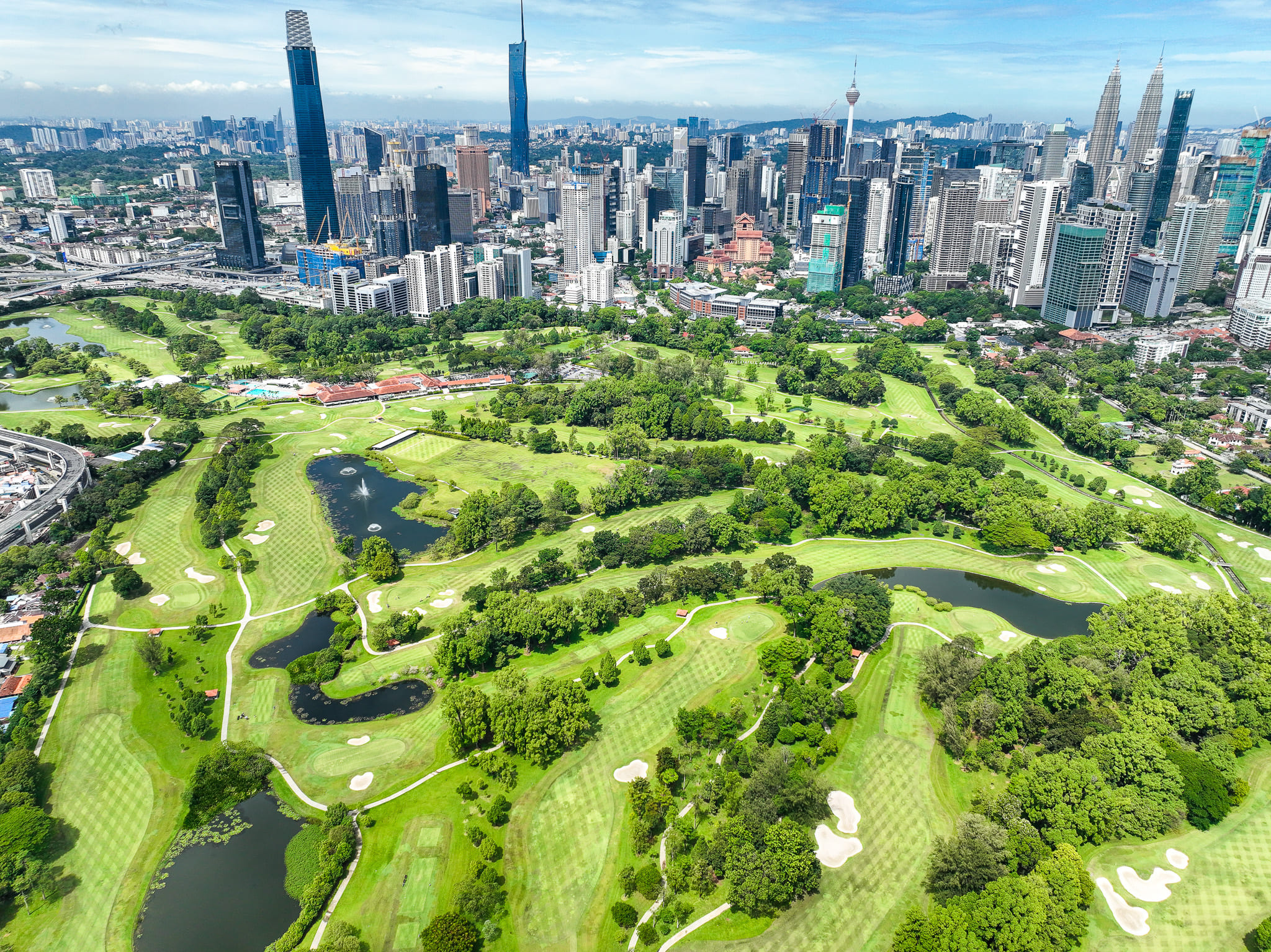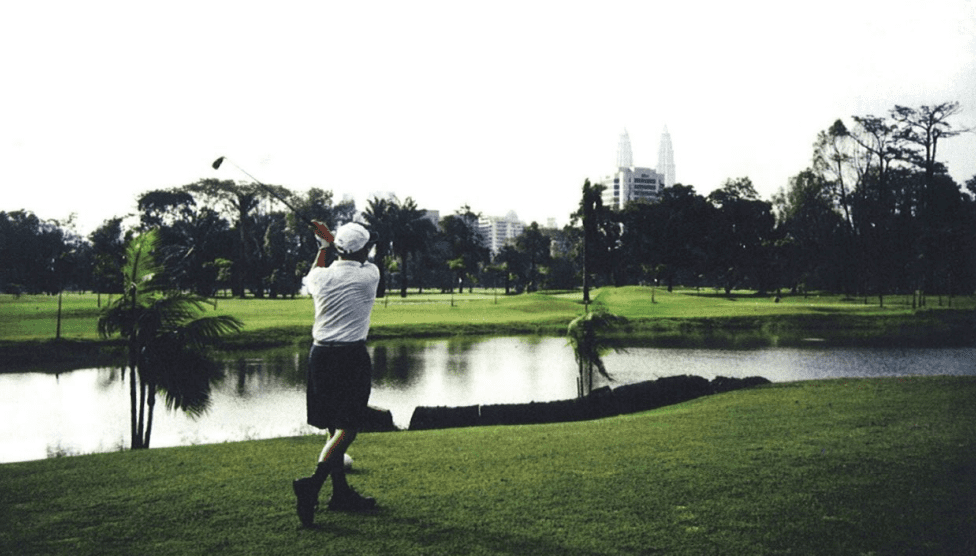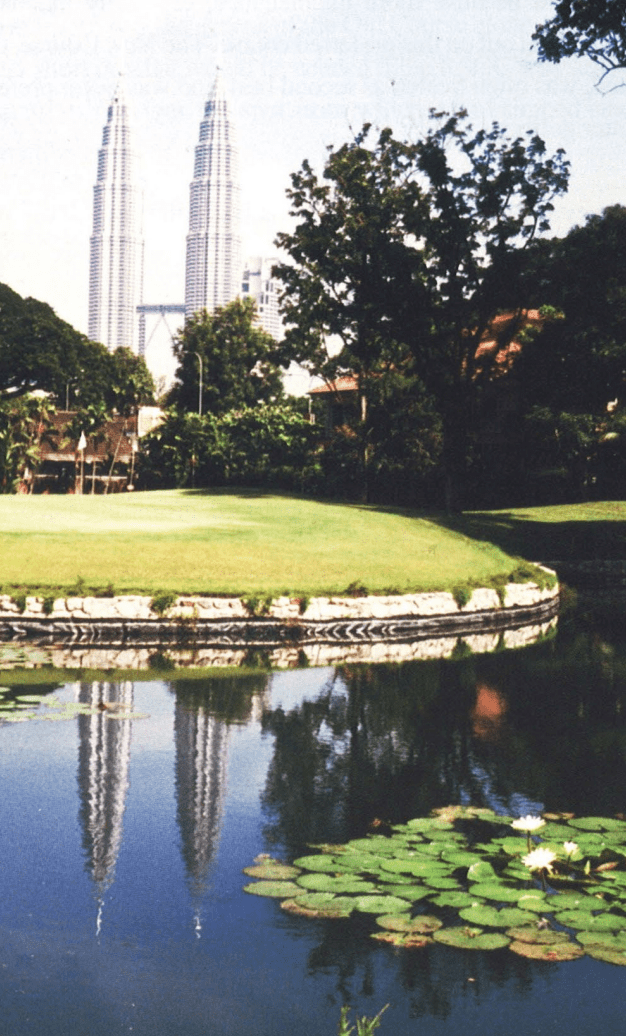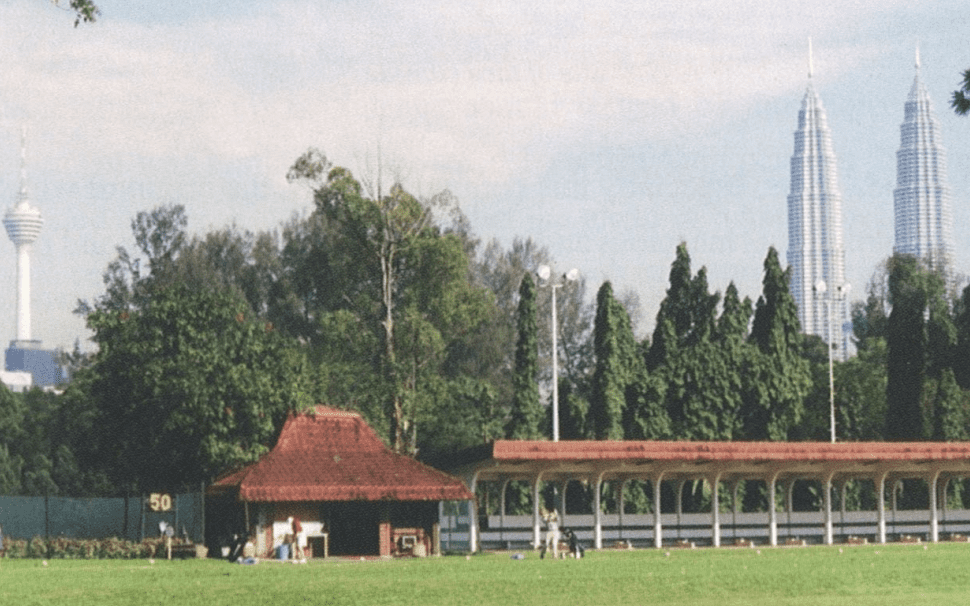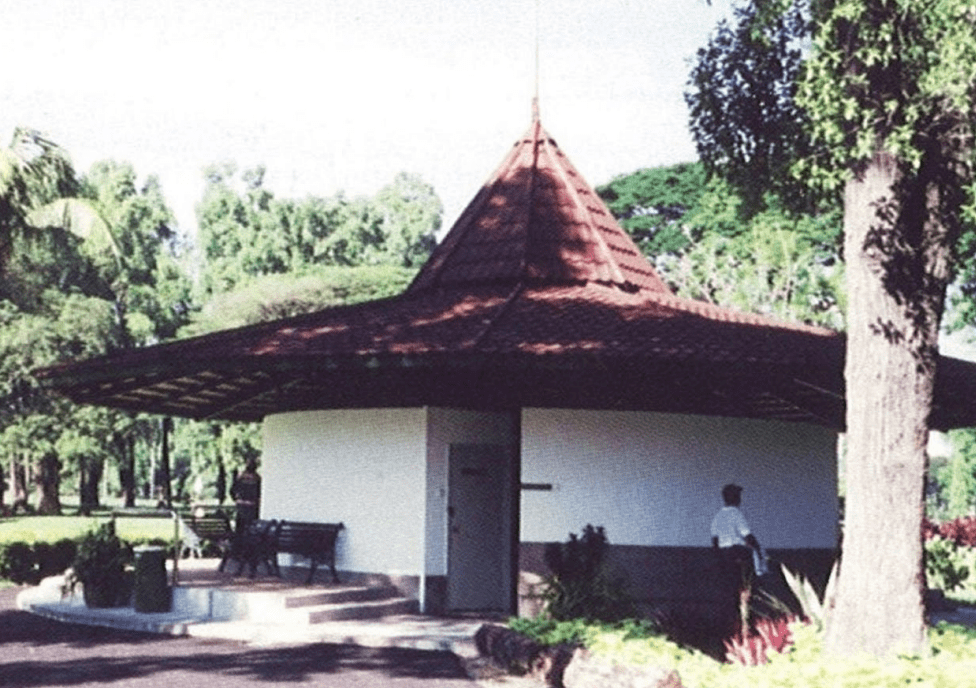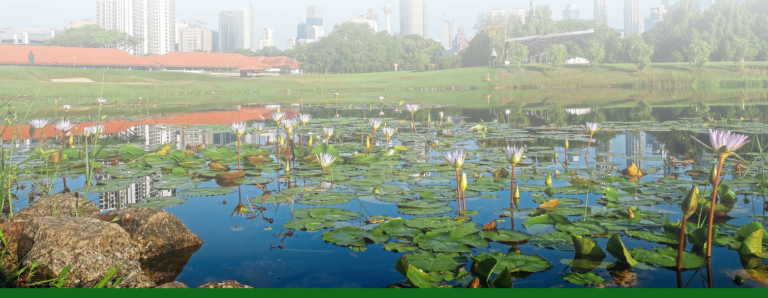7th hole Suleiman Course (2008)
THE REBUILDING OF THE SULEIMAN COURSE AND 1ST NINE NEW COURSE
The Suleiman Course was originally constructed in the early 1950s from the RM20,000 (a big sum then) donated by some RSGC Members who were also members of the Sulaiman Club in Cheras, and had received this money as compensation paid by the government for the acquisition of their club for the development of the Lady Templer Hospital (now part of University Kebangsaan Malaysia). This was a short course consisting of par-3s and par-4s, and was considered an ideal practice course level golf course a contract for design-and-build was awarded to a firm called Borneo Landscape Services in 1998, and the course superintendent, Scott Patterson, was put in charge of supervision. The fairways were grassed with Bermuda grass, and 3 greens were planted with a new super-dwarf Bermuda called MS Supreme, a grass that had just come out of the United States. The other 6 greens were planted with Tifdwarf. When this project was finished in mid-1999, the Committee decided that the 1st Nine New Course should also receive an upgrade. Once again, the impetus came from the desire for beginners or those who wanted to work on their short irons.
However, the Suleiman was usually deserted except for the occasional father who wanted to teach his young children how to play golf. During the reconstruction of the 2nd Nine Old in 1991 earth dug to deepen the lake between holes 15th and 16th were dumped on the 4th and 5th of Suleiman, effectively turning it into a 7-hole course. This, and the need to upgrade the course to attract more golfers prompted the Committee in 1997 to undertake a redesign involving the fairways, tees, bunkers and greens. Since this was not meant to be a tournament level golf course a contract for design-and-build was awarded to a firm called Borneo Landscape Services in 1998, and the course superintendent, Scott Patterson, was put in charge of supervision.
The fairways were grassed with Bermuda grass, and 3 greens were planted with a new super-dwarf Bermuda called MS Supreme, a grass that had just come out of the United States. The other 6 greens were planted with Tifdwarf.
When this project was finished in mid-1999, the Committee decided that the 1st Nine New Course should also receive an upgrade. Once again, the impetus came from the desire to host the next Eisenhower Cup and the Esperito Santo Trophy that was to be held in 2002. Borneo Landscape once again was awarded the design-and-build job.
Some holes were lengthened, and small ponds were dug at the 5th hole and the 6th hole, on the former to toughen the approach to the green, and on the latter to beautify it. But the greatest changes involved the greens that were completely redesigned, and, most significantly, they were planted with the new super-dwarf, MS Supreme.
As it turned out, although Malaysia won the hosting rights to the world amateur events, they were played at the Saujana Golf & Country Club.
Within a few short months of the completion of the renovation, the course superintendent reported that the MS Supreme was not adapting well to our climate, and it struggled and did not fulfill its promise of good, fast greens. Worse, the greens were soon infested by a strain of coarse Bermuda grass, which eventually overcame the MS Supreme.
THE RECONSTRUCTION OF 2005
The Problem with The Greens
By the early years of the new millennium it was obvious that not only were the greens of the 1st Nine New badly infested by this common strain of coarse Bermuda, the 2nd Nine New was even more adversely affected. An investigation carried out in July 2004 found that most of the greens of the 2nd Nine New Course were in fact almost completely taken over by the common Bermuda. Putting speed was almost never more than 7 feet on the Stimpmeter, and the ball roll was bumpy.
Bermuda grass, especially of this common variety, the origin of which was unknown, is tenacious and could survive harsh weather and poor soil conditions. It was particularly virulent and hardy, and would spread very quickly once it was introduced into the soil. The opposite was true of the fine leaf grass like the Tifdwarf or the “super dwarfs” such as the MS Supreme, which need close attention, a near perfect growing medium, good sunshine, adequate water, and a balanced nutrient programme to thrive. Such conditions were not always present, and the field staff did not always understand the needs of these grasses. Thus, through a combination of ignorance and neglect, common Bermuda was able to infiltrate the greens, and once there, it spread like measles, and was soon impossible to weed out Common Bermuda infestation on the Old Course greens was better controlled because more maintenance, especially manual weeding, was carried out on this preferred course. The New Course, on the other hand, was often treated as second best, and was never preferred by the better golfers.
However, the Old Course greens had other problems instead. By 2004 the Tifdwarf that was planted on them was more than 10 years old. This “wonder grass”, as it was touted to be when first introduced to golf courses in 1965, had a tendency to mutate when subjected to environmental, chemical or physical stress. Old greens, therefore, may have several mutations, each with different growth and leaf characteristics. This made their maintenance very complex as each had different nutritional and grooming needs. But most importantly, these different grasses made for poor putting and led to speed inconsistency across all greens as each one had a different combination of sub-species.
The problems with the Old Course greens prompted attempts in 2002 and 2003 to regrass them, with the secondary objective of introducing new designs. The 6th and the 13th greens were both treated this way, and there was a plan to similarly redo all the other Old Course greens. However, this plan was not carried further beyond these two greens. A different scheme of things was soon to come.
The old Driving Range
Driving Range 2018
DREAM BIG
Soon after Yong Poh Kon was elected Captain in June 2004, he suggested that the Club should follow through with the earlier idea to improve the golf courses. However, he felt that if the Club were to merely aim at improving the greens of the Old Course alone, the effort would fall far short of what would be needed if the RSGC was serious about regaining its previous top spot from which it had slipped since the reconstruction effort of 1981. The fact that the Malaysian Open was no longer held here – the last one was played in 2002, and even then it was after a lapse of 8 years since 1994 – clearly signalled that even in the Klang Valley there were golf courses considered superior to ours. Despite the untiring efforts of every captain to make improvements to both courses, those efforts proved inadequate, largely due to budgetary constraints imposed by the Club’s deteriorating financial condition at the time.
By good fortune, if it could be called that, the government had in April 2003 acquired some small parcels of Club land along Jalan Tun Razak near the old Jalan Kampong Pandan roundabout (since demolished) to facilitate road expansion and construction. The compensation sum came to RM24.2 million.
Ambition was now enabled by financial means. It was now possible, for the first time in years, to think big and to chase big dreams.
The new Committee proceeded immediately to draw up preliminary plans. Being a Members’ club, an ambitious plan would be useless unless Members would support it. An informal consultation was thus planned at which an outline of the proposed scope of reconstruction would be unveiled to gauge Members’ reaction. This dialogue was held on 4th August 2004, at which Members were briefed on the research done two months earlier, and why it was thought necessary to carry out a comprehensive reconstruction of both the New and the Old Course.
They were briefed on the recent history of course renovation, the problems encountered by the Field Department especially about the problems related to the greens, and the discovery that most greens were at variance to the accepted USGA standard of construction, and how such non-uniform greens were a nightmare to maintain. The Green Convenor then laid out a brief proposal to reconstruct all 36 holes to improve drainage and with greens that would be built to USGA standards and grassed with Tifdwarf. These courses, he said, would then be up to championship standards.
Members were also told of the plan to install irrigation to the fairways so that brown fairways would be a thing of the past, and that a new fairway grass called Zoysia would be grown in place of the native “cow grass” to improve the playing surface. Random “ponding” of the flattish fairways from rain would be largely eliminated, as there would be a plan to introduce a more effective system for fairway drainage.
When the meeting was opened for questions, a Member queried the wisdom of choosing Tifdwarf, arguing that clearly that grass had not performed to expectations, and pointed out that Serangoon, so successfully grown in Subang, should instead be the choice. This argument was reminiscent of the debate that took place in 1981 as reported earlier. It was apparent that the ghost of Serangoon had not quite been exorcised by the powerful speech of Tommy Lee a quarter of a century earlier.
A litany of negatives against Serangoon was brought out in defense of the proposal to use Tifdwarf. It was a broad leaf grass, and as such it could not give the smooth putting surface that a wellmaintained Bermuda grass could. Further, Serangoon had a tendency to thatch up and become too firm, making backspin difficult. It also had a pronounced directional growth habit that made putting speed along the grain too fast and against the grain too slow. For these reasons, Tifdwarf was still the preferred choice even though we knew this grass would mutate, but the problem could be solved by regularly regrassing the greens every 7 – 10 years as was recommended.
Members were told that our ambition was to produce two championship courses, and that the New Course would be brought up to the championship standard of the Old Course. Despite some reservations especially with regards to the use of Tifdwarf, there was sufficient positive response for the Committee to take its plan a big step forward.
Trumpet trees at the Suleiman Course (2018)
CHOOSING THE ARCHITEC
In this day and time, a competent golf course architect had to be engaged for such an ambitious project. It would have been unthinkable to use the group-of-enthusiasts approach.
Wasting little time, on 4th October 2004, a selection Subcommittee was formed and it solicited for possible candidates. An early decision was made that big-name architects should not be employed, for they were known to charge high fees of several million U.S Dollars, but instead to find a firm that had done work in Malaysia or in ASEAN as it would have the experience of designing to suit local weather conditions. Further, the Sub-committee felt that this was an existing Members’ club, and as such, there was no need to use a big name to attract Members as new clubs would need to do.
The advertisement drew seven interested parties, from which the Selection Sub-committee winnowed down to two for the final interview. The judging was to be based on the concept master plan that each had prepared, and secondly, on the quantum of fees, in that order of importance.
At the end of the long presentation, it was judged that Nelson & Haworth, a firm that had designed three golf courses in Malaysia including the muchacclaimed Shan Shui in Tawau, had the better concept and they had hewed much closer to the design brief that the Selection Subcommittee had drafted. And as it fortuitously turned out, N&H also proposed the lower fee of the two, but this was unknown at the time when the concept plans were being judged. The fee proposal was sealed in a separate envelope.
There were several key elements to the brief. First and foremost, the aim was to produce two championship golf courses, for if there was only one, and if the New Course were to remain the “junior course”, traffic would concentrate on the Old Course as in the past, and if there was a major competition both courses could not be used simultaneously.
Secondly, it was vital that the reconstructed courses retained the parkland feel and look of the existing courses with trees as a paramount feature. Thirdly, the courses should be both challenging to the professionals as well as being interesting and playable by Members. This last objective was easy to enunciate, but in reality was difficult to attain, as recently built championship golf courses worldwide tended to be very long, about 7400 yards, and had difficult greens guarded by formidable bunkers. Those features made golf difficult for the average club player. Thus it was essential that forward tees be built to shorten the course for Members.
In October the design contract was awarded to Nelson & Haworth for the sum of RM888, 000, an auspicious sounding figure in Chinese. Brett Mogg, one of two partners of N&H, would be the architect in charge. Working quickly, the Reconstruction Ad Hoc Committee had by December produced an estimated budget based on the preliminary master plan, and was ready to go to the membership for approval.
6th Hole Drink Hut Old Course (2008)
Credit to YK Liew – Excerpt from the book ‘The RSGC: Veritably A Royal Heritage’

